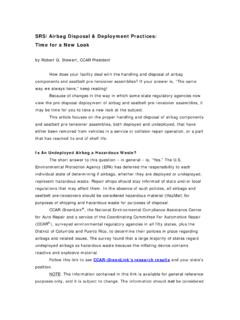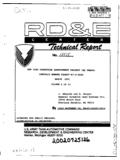Transcription of Rail Shunt Connection Test System - NURail Center
1 rail Shunt Connection Test System Samuel Scott, Frank BeFay, Sean Massey, Alexander Pate, michigan Technological University In the rail industry, a Shunt merely consists of C-clamps and low resistance wire. This is made in order to simulate the conditions of the track while a train is passing over it whe the axles create a very low resistance Connection across the tracks. This enables various signal protocols to take place. However, in the simplicity of the design there is a lack of assurance that the Shunt Connection is effective in recreating these conditions, posing potential threats to calibration and safety of rail workers and equipment. Introduction This project explored the key features and practical implications of a device by which the effectiveness of a rail Shunt can be measured. Prompted by Union Pacific Railroad Corporation, the project was built around ensuring the safety of the thousands of linemen who work for Union Pacific on the rail System every day.
2 Consider a situation where workers are out on a track repairing tracks, calibrating equipment, or performing general maintenance on the tracks. In order to ensure that the workers are safe, a Shunt is used to mirror the conditions which the track can see when a train is passing through a powered section. This tells the dispatch office that something is on the tracks within that section. It is irrelevant whether that something is a train, equipment, or workers as dispatch isn t able to tell the difference. However, what the Shunt does is inform them that something is on the tracks at that location. This allows them to divert trains from entering the area, reducing the danger to equipment and personnel, and preventing interference with whatever operations may be ongoing. Without an adequate Shunt , these precautions fall short and the people and equipment which may be in the location in question could be in danger.
3 A rail Shunt is defined as a low-resistance wire apparatus, which, when clamped to the parallel tracks, will create a short-circuit between them. This is done to mimic the conditions present when a locomotive or rail car is shorting a section of powered rail . In order to be an effective Shunt , the total resistance between the rails at the location of the Shunt must be less than or equal to .Due to inadequate clamping force, corrosion on the rail and/or clamps, or other on site conditions, an effective Shunt is not necessarily always achieved. The task provided was to design and develop a System which will both measure the Shunt effectiveness and communicate the success or failure of the Shunt given the Shunt criteria above while not interfering with already present track signals being transmitted through the railways. Figure 1.
4 rail Shunt Connection test System Design Given that there are many signals present in railways depending on the region of operation, it is important to create a System that is generalized enough to work on any set of tracks regardless of signals present without interfering. Provided by Union Pacific, the current state of track signals can range from: 1. Frequencies between 40 Hz 20kHz 2. DC Voltages up to 3V Due to a variety of operating regions, the weather conditions of different areas can affect the operation of the Shunt . It is important to design a System that will National University rail Center NURail Research Brief operate under the temperature extremes of all environments it will experience. In the initial stages of the design, a decision matrix was used in order to come up with ways to complete the project given the importance of various aspects of the System .
5 The microcontroller option with the existing Shunt was the best option given the criteria and weighting applied. This provides simple operation at low costs with a light-weight System and small form-factor. The proposed solution included multiple point clamps, a custom electric circuit, a microcontroller and an instant feedback and status display. The primary source of measurement selected was a Kelvin Bridge. Shown in Figure 1, conceptually the Kelvin Bridge pushes power, in this case current, through a resistor of unknown value and then measures the resulting voltage and current. With that information, the unknown resistance can be calculated. Figure 1: Kelvin Bridge The core component of this design is a microcontroller which will turn on the current source and push current through the Shunt .
6 An amplifier will amplify the signal so that it can be filtered, using a band pass filter (BPF), and input into the ADC module for examination. As we push a sinusoidal current through the Shunt , it may interact with other signals present through harmonics, interference, or DC voltage offsets. The amplifier bumps the voltage signal from the Shunt to a large enough value to push through the band pass filter. This isolates the frequency that we are using and eliminates the interference from the signal, resulting in an accurate reading of the Shunt signal. Results The lab results showed success in creating a working prototype. An algorithm built into the device works with the sensors to measure the accuracy of the device and compare it to the required resistance. From these we can determine if the Shunt creates a good Connection or a bad Connection .
7 These results are then fed into a user interface consisting of LEDs to give feedback to the user. The user will have instant feedback if the Connection was achieved and if it was good enough to satisfy the job accuracy of the device will depend upon the current sensing resistor and the ability of the microcontroller to read and average the voltage measurements correctly and symmetrically. Build Time and Integration The time to integrate this System onto existing shunts in the field can vary depending on how much the System can be simplified. The current prototype is built into modules. This form factor however is not ideal. An ideal System would consist of a single System board with all buttons, chips, and power supply all integrated into one. With the existing modular System we estimate a user can build this device in 1 to 2 hours depending upon skill level and familiarity of System .
8 A more efficient single board and all in one unit this could lead to major reductions in assembly time. Costs We estimate the cost to build the existing prototype at approximately $200. This estimate uses materials bought in single quantities, cost reduction from buying bulk parts is not included in this estimate. The production level cost should be much less than this. Conclusion Following extensive experimentation on rails provided by Union Pacific, the retrofitted clamps and electronics were able to confirm Shunt status. It was able to do this consistently and repeatedly. We also tested for long time durations, far exceeding those normally experienced in the field. With further development and testing, this unit could be easily retrofitted to any and all standard Shunt units for a very low cost, especially when weighed against the cost of equipment and lives.





